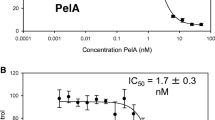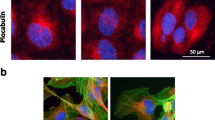Abstract
The discovery of molecules with anti-angiogenic properties has led to promising new strategies for the treatment of diseases characterized by excessive new vessel growth, such as cancer and haemangioma. We have assessed the effects of DNA-damaging and cytoskeletal-disrupting agents in vitro on several endothelial cell functions. We report that bleomycin, mitomycin C and cytoskeletal-disrupting drugs (2-methoxyestradiol, taxol, vincristine, vinblastine, colchicine, nocodazole, and cytochalasin D) exhibit anti-angiogenic activities of varying potency. Bleomycin and the various cytoskeletal-disrupting drugs inhibited endothelial cell migration, while mitomycin C had a marginal effect. Both DNA-damaging and cytoskeletal-disrupting drugs decreased endothelial cell growth in a dose-dependent manner, and this was accompanied by the induction of apoptosis. The growth inhibitory and apoptotic effects of cytoskeletal-disrupting drugs were the most pronounced. We also show that both classes of drugs inhibited capillary-like tube formation in an assay of in vitro angiogenesis, with cytoskeletal-disrupting agents inhibiting in vitro angiogenesis with greater potency. A targeted approach incorporating several compounds with different mechanisms of action may be useful for the treatment of angiogenesis-dependent diseases such as hemangiomas of infancy.





Similar content being viewed by others
References
Enjolras O (1997) Management of hemangiomas. Dermatol Nurs 9:11–17
Muir T, Kirsten M, Fourie P et al (2004) Intralesional bleomycin injection (IBI) treatment for haemangiomas and congenital vascular malformations. Pediatr Surg Int 19:766–773. doi:10.1007/s00383-003-1058-6
Hasan Q, Tan ST, Gush J, Peters SG, Davis PF (2000) Steroid therapy of a proliferating hemangioma: histochemical and molecular changes. Pediatrics 105:117–121. doi:10.1542/peds.105.1.117
Pepper MS (1997) Manipulating angiogenesis. From basic science to the bedside. Arterioscler Thromb Vasc Biol 17:605–919
Mulliken JB, Glowacki J (1982) Hemangiomas and vascular malformations in infants and children: a classification based on endothelial characteristics. Plast Reconstr Surg 69:412–420
Takahashi K, Mulliken JB, Kozakewich HPW, Rogers RA, Folkman J, Ezekowitz RAB (1994) Cellular markers that distinguish the phases of hemangioma during infancy and childhood. J Clin Invest 93:2357–2364. doi:10.1172/JCI117241
Pepper MS (2001) Role of matrix metalloproteinase and plasminogen activator-plasmin system in angiogenesis. Arterioscler Thromb Vasc Biol 21:1104–1117. doi:10.1161/hq0701.093685
Folkman J (2003) Angiogenesis and apoptosis. Semin Cancer Biol 13:159–167. doi:10.1016/S1044-579X(02)00133-5
Polunovsky VA, Wendt CH, Ingber DH, Peterson MS, Bitterman PB (1994) Induction of endothelial cell apoptosis by TNFα: modulation by inhibitors of protein synthesis. Exp Cell Res 214:584–594. doi:10.1006/excr.1994.1296
Holmgren LL, Garcia I, Jimenez B, Mandriota SJ, Borlat F, Sim BKL et al (1998) Multiple forms of angiostatin induce apoptosis in endothelial cells. Blood 92:4730–4741
Pandya NM, Dhalla NS, Santani DD (2006) Angiogenesis-a new target for future therapy. Vascul Pharmacol 44:265–274. doi:10.1016/j.vph.2006.01.005
Dirix LY, Libura M, Vermeulen PB et al (1997) In vitro toxicity studies with mitomycins and bleomycin on endothelial cells. Anticancer Drugs 8:859–868. doi:10.1097/00001813-199710000-00007
Ingber DE, Prusty D, Sun Z et al (1995) Cell shape, cytoskeletal mechanics, and cell cycle control in angiogenesis. J Biomech 28:1471–1484. doi:10.1016/0021-9290(95)00095-X
Klauber N, Parangi S, Flynn E et al (1997) Inhibition of angiogenesis and breast cancer in mice by the microtubule inhibitors 2-methoxyestradiol and taxol. Cancer Res 57:81–86
Stafford SJ, Schwimer J, Anthony CT et al (2005) Colchicine and 2-methoxyestradiol inhibit human angiogenesis. J Surg Res 125:104–108. doi:10.1016/j.jss.2004.11.017
Montesano R, Orci L (1985) Tumor-promoting phorbol esters induce angiogenesis in vitro. Cell 42:469–477. doi:10.1016/0092-8674(85)90104-7
Sarihan H, Mocan H, Yildiz K, Abes M, Akyazici R (1997) A new treatment with bleomycin for complicated cutaneous hemangiomas in children. Eur J Pediatr Surg 7:158–162. doi:10.1055/s-2008-1071080
Kullendorf CM (1997) Efficacy of bleomycin treatment for symptomatic hemangiomas in children. Pediatr Surg Int 12:526–528. doi:10.1007/BF01258718
Pienaar C, Graham R, Geldenhuys S, Hudson DA (2006) Intralesional bleomycin for the treatment of hemangiomas. Plast Reconstr Surg 117:221–226. doi:10.1097/01.prs.0000194906.61805.b0
Mabeta P, Davis PF (2008) The mechanism of bleomycin in inducing haemangioma regression. S Afr Med J 98:538–539
Catchpoole DR, Stewart BW (1995) Formation of apoptotic bodies is associated with internucleosomal DNA fragmentation during drug-induced apoptosis. Exp Cell Res 216:169–177. doi:10.1006/excr.1995.1021
Elmore S (2007) Apoptosis: a review of programmed cell death. Toxicol Pathol 35:495–516. doi:10.1080/01926230701320337
Mandriota SJ, Pepper MS (1997) Vascular endothelial growth factor-induced in vitro angiogenesis and plasminogen activator expression are dependent on endogenous basic fibroblast growth factor. J Cell Sci 110:2293–2302
Pepper MS, Hazel SJ, Humpel M, Schleuning W-D (2004) 8-Prenylnaringenin, a novel phytoestrogen, inhibits angiogenesis in vitro and in vivo. J Cell Physiol 199:98–107. doi:10.1002/jcp.10460
Pepper MS, Ferrara N, Orci L, Montesano R (1992) Potent synergism between vascular endothelial growth factor and basic fibroblast growth factor in the induction of angiogenesis in vitro. Biochem Biophys Res Commun 189:824–831. doi:10.1016/0006-291X(92)92277-5
Acknowledgments
We would like to thank Corinne Di Sanza and Mireille Quayzin for excellent technical assistance. We also thank Prof Piet Becker, Biostats Unit, Medical Research Council, for assistance with statistical analysis. This work was funded by the Swiss National Science Foundation (grant no. 3100-064037.00 to MSP) and the National Research Foundation.
Author information
Authors and Affiliations
Corresponding author
Rights and permissions
About this article
Cite this article
Mabeta, P., Pepper, M.S. A comparative study on the anti-angiogenic effects of DNA-damaging and cytoskeletal-disrupting agents. Angiogenesis 12, 81–90 (2009). https://doi.org/10.1007/s10456-009-9134-8
Received:
Accepted:
Published:
Issue Date:
DOI: https://doi.org/10.1007/s10456-009-9134-8




